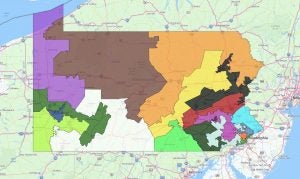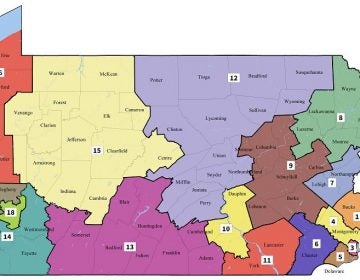Some worry Pa. court’s congressional map dilutes black votes
The 2rd district now appears to have nearly 10 percent fewer black voters than the corresponding district did in the previous map.

Representatives from Common Cause Pennsylvania largely praised the new map, but noted they have concerns about how it will impact black voters' representation. (Katie Meyer/WITF)
Political groups around Pennsylvania are working to figure out what the state Supreme Court’s new congressional map will mean for their agendas.
Several organizations that have backed efforts to redraw the districts say they are concerned that the new plan may dilute votes from black communities.
When drawing congressional maps, one key standard authors have to meet comes from the Voting Rights Act.
Broadly, the act is designed to make sure minority voters aren’t disenfranchised, and it includes a provision requiring something called majority-minority districts. That means areas with mostly black voters should be mostly black districts, to make sure their votes aren’t diluted.
Under Pennsylvania’s now-unconstitutional congressional map, black voters had an overall majority in the 2nd Congressional District, and they had a plurality in the 1st (i.e. they were the biggest racial group, but didn’t outnumber Hispanic, white, and Asian voters combined).
The court’s new map completely re-numbers all the state’s districts, so it can be confusing to compare specific ones. But the districts with the largest proportions of black voters are now the 2nd and 3rd.
The new 3rd Congressional District still has an overall majority of black voters, albeit a slightly smaller one.
But the 2rd district now appears to have nearly 10 percent fewer black voters than the corresponding district did in the previous map.
Senate Democratic Appropriations Chair Vincent Hughes said his staff have been analyzing the new map, and “the predominant voting constituency in this new district is the white population, whereas the predominant population in the previous configuration would have been the African American community.”
Hughes, a member and former chair of the Pennsylvania Legislative Black Caucus, stopped short of saying that change violates the Voting Rights Act.
But he said it’s certainly significant.
“I think the best way to say it is that the influence of the African American population … it appears that that’s been diminished,” he said.
Common Cause Pennsylvania’s Executive Director Micah Sims said his organization, and the NAACP, are currently considering whether to contest the map on the grounds it might violate the Voting Rights Act.
“If it needs to go, I think they’ll probably do it,” he said, referring to filing a lawsuit. “The NAACP continually has fought to make sure equality exists in the commonwealth of Pennsylvania, and I think they’re going to fight for that in this pursuit as well.”
However, Sims noted that overall, the new map gives Democrats stronger representation than the old one.
Democrats in Pennsylvania have slightly more registered voters than Republicans do. But under the congressional map drawn in 2011, they have won just five of 18 seats in three consecutive elections.
Analyses project they may see anywhere from eight to 11 wins under the new map. And Sims said that is a calculation the groups — which have vocally pushed for a more equal congressional split — are weighing.
“I would say if we’re going to hold to our values that we’ve lifted up, of fairness, competitiveness, and equality, the map may be worth [keeping],” he said.
Hughes took a similar stance.
“The map has advanced forward the issue of fairness and the issue of getting rid of political gerrymandering,” he said. “However you can’t run away from the numbers — in this [2nd] Congressional District, there’s been a reduction in the African American population.”
The NAACP has not responded to a request for comment. Sims said he has spoken with lawyers for the organization who are reviewing the situation.
Meanwhile, Republicans in the House and Senate plan to sue in federal court to try and get the state Supreme Court’s new map overturned.
Their argument will likely be that the court doesn’t have the constitutional authority to draw new maps in this case — not that the map disenfranchises minority groups.
WHYY is your source for fact-based, in-depth journalism and information. As a nonprofit organization, we rely on financial support from readers like you. Please give today.







